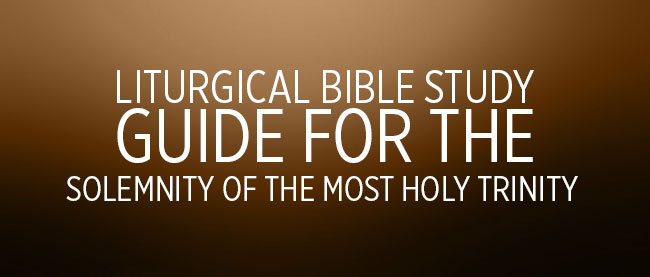Introduction
The dogma of the Trinity has not always been clearly defined. In fact, the word “Trinity” does not appear in Holy Scripture (neither does the word “pope,” “purgatory,” or “catholic” for that matter; as our fundamentalist brothers and sisters will be quick to point out). It is not even clear how the doctrine was understood in the time of the apostles. Through the first century of Christianity, the Church grew in its awareness of the mystery of the Trinity. The oldest doctrinal formulation of the Church’s belief in the Trinity is in the Apostle’s Creed, which, in the form of the ancient Roman baptismal symbol, served as the basis of catechumical instruction and as a baptismal confession of faith since the 2nd century.
In the early Church Christians began to ponder the mystery of God’s unity and the Trinity and attempted to explain more precisely the relationships among the persons of the Trinity. The use of the term “Trinity” (Greek: trias) first appeared in the 2nd century in the writings of Theophilus of Antioch. The efforts to explain the relationships among the persons of the Trinity led to many errors in the early years, and most of those who tried to describe the relationships ended in heresy. Even the great theologians Tertullian and Origin stumbled into error in their attempts to explain the relationship between the Father and the Son. Arius, around the year A.D. 300, concluded that the Word (logos) of God was created by the Father to be the instrument of all other creation. The Word, the Son of God, was a perfect creature to Arius, but a creature nonetheless. Were this account true, then only the Father would be truly God, and the Son and Holy Spirit would then be divine only through adoption by the Father. In such a case, the Most Holy and Undivided Trinity would become merely a descending hierarchy with the Father extending His grace to the Son and the Holy Spirit, rather than a communion of co-equal and co-eternal persons, who together are the one, true God. The First Council of Nicaea (A.D. 325) was convened to answer the heresy of Arianism and that council clearly stated the “consubstantiality” of the Son with the Father. The First Council of Constantinople (A.D. 381) affirmed that the Spirit must be adored and glorified together with the Father and the Son. Arianism finally died out almost 500 years later at the end of the 7th century but it has been revived in the teaching of the Jehovah’s Witnesses and the Mormons.
It wasn’t until the Second Council of Constantinople (A.D. 553) that the dogma of the Trinity was clearly enunciated and its technical expression was fixed.
The creed which we call the Nicene Creed, originated at the First Council of Nicaea in A.D. 325 and was further amplified by the First Council of Constantinople in A.D. 381. It was probably introduced into the western liturgy by the regional Council of Toledo in A.D. 589. That text, however, was a Latin translation of the Greek original and included a small addition which resulted in major theological disputes, namely, that the Holy Spirit “proceeds” from the Father and the Son, rather than only from the Father. This matter continues to divide Catholic and Protestant Christians from Eastern Orthodox Christians.
1st Reading – Proverbs 8:22-31
The concept of wisdom is elusive because it is exceedingly complex. Wisdom can stand for the skill of a craftsman, such as that possessed by those who made Aaron’s vestments (Exodus 28:3) or by the carpenters who constructed the Mosaic tabernacle (Exodus 31:3-5; 36:1). It denotes the ability of a professional mourner (Jeremiah 9:17) or a sailor (Psalm 107:27). The sage is an adviser to kings (Jeremiah 50:35; Proverbs 31:1) but is also an astute old woman (2 Samuel 20:16). It also has an intensely religious aspect: fear of the Lord (Proverbs 1:7; Sirach 1:9-10). Today we hear it being described as from God (divine) and absolutely prior to the visible universe. This priority implies superiority to all created things.
2nd Reading – Romans 5:1-5
The Letter to the Romans is the only writing of Paul’s which is addressed to a church (congregation) which he did not establish. It does not answer questions posed by the congregation or even provide a summary of Christian doctrine. Rather, it presents his missionary reflections on the possibility of salvation now offered to all men, vice only the Jews, in the Good News of Christ Jesus. Paul realizes that man’s justification and salvation depend not on the “deeds of the law” but on faith in Christ Jesus, the Son whom the Father’s love did not spare (as compared to Isaac). Through faith man shares in the effects of the plan of salvation conceived by the Father and brought to realization in the death and resurrection of Jesus. Today we hear him allude to the theological virtues of faith, hope, and charity love).
Gospel – John 16:12-15
All through the season of Easter our Gospel reading was from Jesus’ final discourse to His disciples; today is no different. The setting is at the Last Supper in the upper room.


